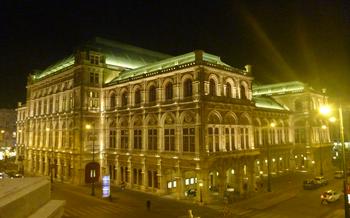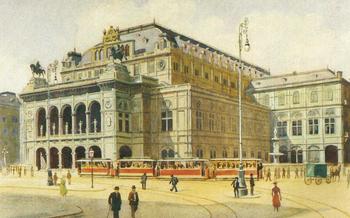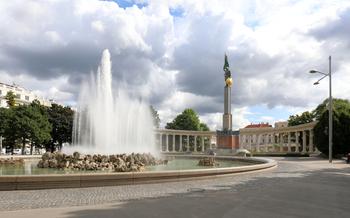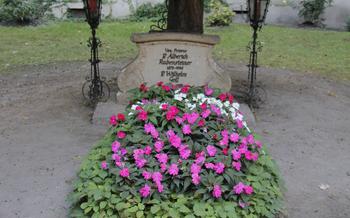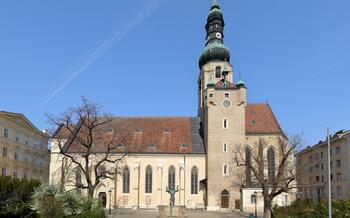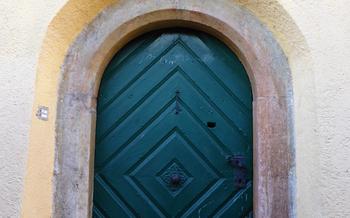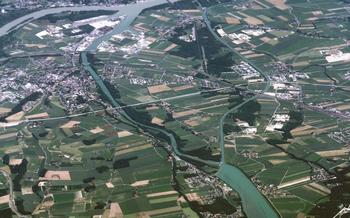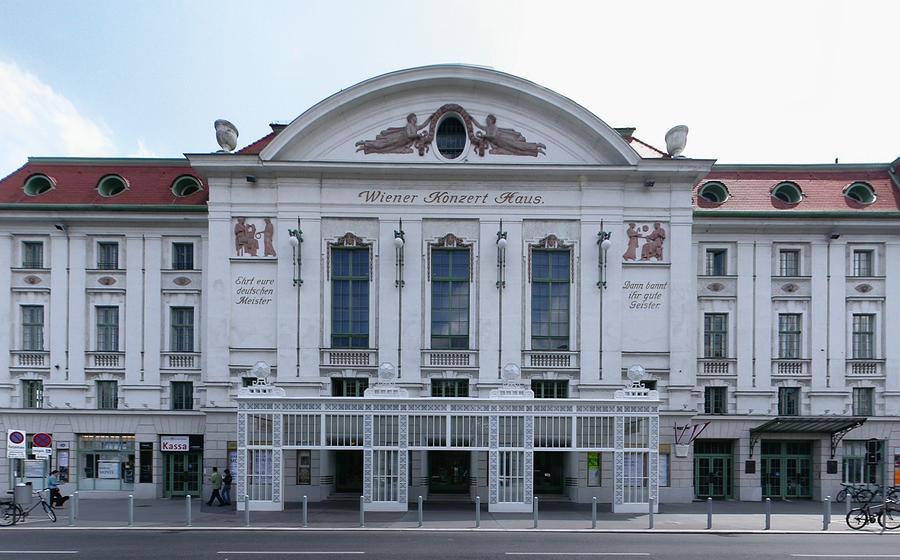
Wiener Konzerthaus
- A musical gem in the heart of Vienna
- The history of the Wiener Konzerthaus
- The architecture of the Wiener Konzerthaus
- The acoustics of the Wiener Konzerthaus
- The main concert hall:
- The other concert halls:
- The Vienna Symphony
- The Vienna Philharmonic
- Other notable performances
- Tickets and prices:
- Dress Code
- Getting there
- Other things to do nearby
- Insider Tip: Unlocking the Secrets of the Wiener Konzerthaus
A musical gem in the heart of Vienna
The Wiener Konzerthaus, a majestic concert hall situated in the heart of Vienna, stands as a testament to the city's rich musical heritage. Its history is deeply intertwined with the evolution of Viennese music, and its architectural beauty and world-renowned acoustics have made it a beloved landmark.
Constructed in 1913, the Wiener Konzerthaus was designed by the renowned architects Ferdinand Fellner and Hermann Helmer. Their vision was to create a concert hall that would rival the Musikverein, another iconic Viennese concert venue. The result was a stunning Art Nouveau masterpiece, with its elegant facade, intricate details, and grand interior spaces.
The Wiener Konzerthaus is known for its exceptional acoustics, which have been meticulously engineered to provide a pure and balanced sound experience. This has made it a sought-after venue for orchestras, conductors, and musicians from around the world. The main concert hall, with its horseshoe-shaped design and seating capacity of over 1800, is particularly renowned for its acoustics and has hosted countless legendary performances.
Located in the heart of Vienna, the Wiener Konzerthaus is easily accessible by public transportation and is surrounded by a vibrant cultural scene. With its rich history, architectural splendor, and world-class acoustics, the Wiener Konzerthaus is a must-visit destination for music lovers and anyone seeking a truly immersive musical experience.
The history of the Wiener Konzerthaus
Originally conceived as the "Great Music Hall," the Wiener Konzerthaus was built in the late 19th century to address the growing need for a dedicated concert venue in Vienna. Before its construction, musical performances were primarily held in theaters and other makeshift spaces. The Konzerthaus was designed to provide a purpose-built facility that could accommodate large-scale orchestral concerts and other musical events.
The Konzerthaus opened its doors in 1913 with a grand inaugural concert featuring the Vienna Philharmonic Orchestra conducted by Gustav Mahler. Since then, it has hosted a remarkable array of musical events, including concerts by legendary conductors such as Herbert von Karajan, Leonard Bernstein, and Carlos Kleiber. The Konzerthaus has also been the venue for numerous world premieres, including Arnold Schoenberg's "Gurrelieder" and Alban Berg's "Wozzeck."
Throughout its history, the Konzerthaus has played a pivotal role in shaping Vienna's musical identity. It has been a home to the Vienna Symphony Orchestra since its foundation in 1900 and has hosted countless performances by the Vienna Philharmonic Orchestra, making it a central hub for classical music in the city. The Konzerthaus has also been instrumental in promoting contemporary music, hosting festivals and events dedicated to new works and emerging composers.
The architecture of the Wiener Konzerthaus
The Wiener Konzerthaus stands as a testament to the architectural prowess of Ferdinand Fellner and Hermann Helmer, two renowned architects who left an indelible mark on Vienna's cityscape. Their unique design for the Konzerthaus masterfully blends the grandeur of the past with the innovative spirit of the Art Nouveau movement.
The facade of the Konzerthaus is a captivating blend of classical and contemporary elements. Its majestic columns and intricate ornamentation evoke a sense of grandeur, while the use of glass and steel adds a touch of modernity. The building's curved lines and asymmetrical design are reminiscent of the Art Nouveau style, which was gaining popularity at the time of its construction.
Stepping inside the Konzerthaus, one is greeted by a breathtaking interior that exudes elegance and sophistication. The grand staircase, adorned with intricate wrought-iron railings, leads visitors to the main concert hall and other performance spaces. The walls are adorned with beautiful murals and sculptures, adding to the artistic ambiance of the building.
Over the years, the Wiener Konzerthaus has undergone several renovations and restorations to preserve its architectural integrity and enhance its functionality. These efforts have ensured that the Konzerthaus retains its original charm while meeting the needs of modern audiences and performers.
The acoustics of the Wiener Konzerthaus
The Wiener Konzerthaus is renowned for its exceptional acoustics, widely considered among the finest in the world. This acoustic excellence is the result of meticulous design, scientific research, and innovative techniques employed during the construction and renovation of the building.
The architects, Ferdinand Fellner and Hermann Helmer, incorporated principles of acoustics into the design from the outset. They carefully calculated the dimensions and proportions of the concert hall, ensuring optimal sound distribution and reverberation time. The use of high-quality materials, such as wood paneling and plaster, further enhanced the acoustic properties of the hall.
Over the years, the Wiener Konzerthaus has undergone several renovations, each with a focus on preserving and improving the acoustics. In the 1970s, a team of acoustic experts conducted extensive research to identify and address any potential acoustic issues. They implemented innovative solutions, such as adjustable panels and sound-absorbing materials, to optimize the acoustics for various types of performances.
Today, the Wiener Konzerthaus is equipped with state-of-the-art acoustic technology that allows for precise control and adjustment of the sound. The hall's unique design, combined with modern technology, creates an immersive and unparalleled auditory experience for performers and audiences alike.
The main concert hall:
The heart of the Wiener Konzerthaus is its main concert hall, a majestic space that exudes grandeur and elegance. With a seating capacity of over 1,800, this magnificent hall is the largest and most prestigious venue within the Konzerthaus. Its horseshoe-shaped design offers an intimate and immersive experience, bringing the audience closer to the performers on stage. The stage itself is a marvel of engineering, equipped with a state-of-the-art orchestra pit that can accommodate up to 120 musicians. The hall has hosted countless legendary performances over the years, from classical concerts by renowned orchestras like the Vienna Philharmonic to contemporary music events and ballet productions. It is here that the Vienna Symphony, the Konzerthaus's resident orchestra, performs its regular concerts, captivating audiences with their exquisite renditions of classical masterpieces.
The other concert halls:
In addition to the main concert hall, the Wiener Konzerthaus features three smaller halls that offer unique acoustics and characteristics. The Mozart Hall, named after the legendary composer, has a capacity of 700 seats and is known for its intimate atmosphere. It is often used for chamber music concerts, recitals, and solo performances. The Schubert Hall, named after another Viennese musical giant, has a capacity of 350 seats and is ideal for smaller ensembles and experimental performances. The Berio Hall, the newest addition to the complex, is a flexible space that can be adapted to various configurations and purposes. It hosts a wide range of events, from contemporary music concerts to jazz performances and film screenings. The diversity of these spaces allows the Wiener Konzerthaus to cater to a broad spectrum of musical genres and artistic expressions.
The Vienna Symphony
The Wiener Konzerthaus is the proud home of the Vienna Symphony, a world-renowned orchestra that has played a pivotal role in shaping Vienna's musical legacy. Since its foundation in 1900, the orchestra has been an integral part of the city's cultural landscape, captivating audiences with their virtuosic performances and extensive repertoire.
Under the baton of renowned conductors, the Vienna Symphony has established a reputation for musical excellence, delivering unforgettable interpretations of classical masterpieces and contemporary works. Their concerts at the Wiener Konzerthaus are highly anticipated events, drawing music lovers from around the world.
Beyond their performances at the Konzerthaus, the Vienna Symphony also embarks on international tours, spreading the joy of classical music far and wide. Their collaborations with distinguished soloists and conductors have produced legendary recordings and performances that have left an indelible mark on the world of classical music.
As the resident orchestra of the Wiener Konzerthaus, the Vienna Symphony plays a crucial role in preserving and promoting the city's rich musical heritage. Their concerts are not just performances; they are celebrations of the power and beauty of music, showcasing the extraordinary talents of the orchestra and the acoustic wonders of the Konzerthaus.
The Vienna Philharmonic
The Vienna Philharmonic is one of the world's most renowned orchestras, and its performances at the Wiener Konzerthaus are highly anticipated events. Founded in 1842, this esteemed ensemble has a rich history and a legacy of musical excellence. Their concerts at the Konzerthaus are characterized by their impeccable precision, profound interpretations, and emotional intensity.
The Vienna Philharmonic's performances at the Wiener Konzerthaus are not only significant for their musical quality but also for their symbolic importance. The orchestra's presence at this prestigious venue underscores Vienna's status as a global center of classical music. Moreover, the orchestra's annual New Year's Concert, broadcast live from the Wiener Konzerthaus, has become a beloved tradition, bringing the joy of Viennese music to millions of homes worldwide.
Listening to the Vienna Philharmonic perform at the Wiener Konzerthaus is a truly unforgettable experience. The orchestra's mastery of the classical repertoire, combined with the exceptional acoustics of the hall, creates a magical atmosphere that transports the audience to a realm of pure musical delight. Whether you are a seasoned concertgoer or a newcomer to classical music, attending a Vienna Philharmonic concert at the Wiener Konzerthaus is an experience that will leave an indelible mark on your memory.
Other notable performances
In addition to the Vienna Symphony and the Vienna Philharmonic, the Wiener Konzerthaus has hosted a multitude of other renowned orchestras and ensembles from around the world. These include the Berlin Philharmonic, the New York Philharmonic, the London Symphony Orchestra, and the Royal Concertgebouw Orchestra, among many others.
Famous conductors who have graced the stage of the Wiener Konzerthaus include Leonard Bernstein, Herbert von Karajan, Claudio Abbado, and Riccardo Muti. Soloists who have performed here include Plácido Domingo, Luciano Pavarotti, Maria Callas, and Anne-Sophie Mutter.
Legendary performances that have taken place at the Wiener Konzerthaus include the world premiere of Gustav Mahler's Symphony No. 8 in 1910, conducted by the composer himself. Other notable performances include the Vienna Philharmonic's New Year's Concert, which has been broadcast to millions of people around the world since 193
The Wiener Konzerthaus has also been a platform for the performance of contemporary music. Many world premieres of new works have taken place here, including pieces by composers such as Arnold Schoenberg, Alban Berg, and Anton Webern.
The diversity of musical genres represented at the Wiener Konzerthaus is truly remarkable. In addition to classical music, the venue has hosted jazz concerts, world music performances, and even electronic music events. This reflects the Wiener Konzerthaus's commitment to presenting a wide range of musical experiences to its audiences.
Tickets and prices:
Attending a concert at the Wiener Konzerthaus is an experience worth splurging on. Ticket prices vary depending on the type of event, seating category, and availability. Advance booking is recommended to secure your preferred seats and avoid disappointment. The Wiener Konzerthaus offers concessions for students, seniors, and groups, making it accessible to a wider audience. Keep an eye out for special discounts and promotions throughout the year.
To get the best seats in the house, consider splurging on a seat in the stalls or Dress Circle. These offer an immersive experience with an unobstructed view of the stage. Side stalls provide good acoustics and value for money. The Upper Circle offers a bird's-eye view of the orchestra and is suitable for those on a budget.
Dress Code
The Wiener Konzerthaus is renowned for its elegant ambiance and rich musical tradition, and maintaining this legacy requires a certain level of decorum among its attendees. While there is no strict dress code enforced, formal attire is highly recommended to honor the occasion and show respect for the performers and the venue.
A well-tailored tuxedo or dark suit with a tie is the classic choice for men, while women can opt for formal dresses, elegant pantsuits, or cocktail dresses. Dress codes may vary for specific events, so it's always advisable to check the concert's program or website for any specific guidelines.
Remember, the dress code is not about exclusivity but about celebrating the shared experience of attending a concert at the Wiener Konzerthaus. Dressing appropriately contributes to the overall atmosphere of sophistication and respect for the musical arts.
Getting there
The Wiener Konzerthaus is conveniently located in the heart of Vienna, making it easily accessible by public transportation. The nearest metro station is Karlsplatz, which is served by lines U1, U2, and UFrom there, it is just a short walk to the Konzerthaus. Alternatively, you can take tram lines 1, 2, or D to the Schwarzenbergplatz stop, which is also within walking distance. If you prefer to take the bus, lines 4A and 59A stop right in front of the Konzerthaus.
For those arriving by car, there are several parking garages in the vicinity. The Musikverein Garage, located opposite the Konzerthaus, offers convenient parking for concertgoers. Other nearby options include the Garage am Heumarkt and the Garage am Ring. Please note that parking in Vienna can be expensive, so it is advisable to arrive early or consider using public transportation.
Other things to do nearby
Beyond the musical wonders of the Wiener Konzerthaus, the surrounding area offers a wealth of attractions to further enrich your visit. Immerse yourself in the cultural heart of Vienna by exploring the Museumsquartier, a vibrant complex housing renowned museums, galleries, and performance spaces. Marvel at the grandeur of the Hofburg Palace, the former imperial residence, and delve into its rich history. A stroll along the majestic Ringstrasse boulevard will lead you past architectural wonders such as the State Opera House, the Parliament building, and the Burgtheater.
As night falls, Vienna's vibrant nightlife scene comes alive. Indulge in a traditional Viennese dinner at one of the many charming restaurants, then immerse yourself in the city's pulsating music scene. From cozy jazz clubs to lively bars and dance floors, there's something to suit every taste. Let the rhythm of Vienna carry you away as you experience the city's infectious energy and passion for the arts.
Insider Tip: Unlocking the Secrets of the Wiener Konzerthaus
Beyond the renowned performances and architectural marvels, the Wiener Konzerthaus holds a treasure trove of hidden gems waiting to be discovered. For a truly immersive experience, embark on a guided tour to delve into the fascinating history and stories behind the scenes. These tours offer a glimpse into the inner workings of the Konzerthaus, showcasing its intricate technical systems and revealing the secrets of its exceptional acoustics.
For a unique perspective, consider attending a rehearsal or open dress rehearsal. These sessions provide an intimate opportunity to witness the preparation and dedication of world-class musicians as they fine-tune their performances.
If you're seeking a truly unforgettable experience, inquire about backstage access. With a bit of luck, you might catch a glimpse of the musicians warming up, the stagehands preparing for the performance, or even have a serendipitous encounter with the artists themselves.
Remember to keep an eye out for special events and exhibitions held throughout the year. These events offer a chance to explore the diverse facets of the Wiener Konzerthaus, from contemporary art installations to themed concerts that push the boundaries of musical expression.
Embrace the local tradition of attending a Heuriger, a traditional Viennese wine tavern, before or after your concert. These cozy establishments offer a delightful ambiance, delicious local wines, and a taste of authentic Viennese culture.
With a little curiosity and an open mind, you'll discover that the Wiener Konzerthaus is more than just a concert venue—it's a cultural labyrinth filled with hidden treasures waiting to be unearthed.
